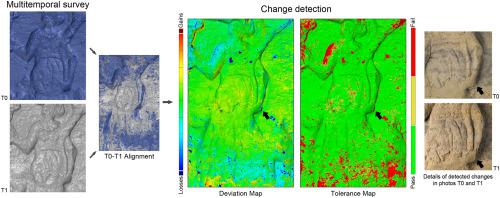Our official English website, www.x-mol.net, welcomes your feedback! (Note: you will need to create a separate account there.)
3D change detection for cultural heritage monitoring: Two case studies of underground sculptural reliefs
Digital Applications in Archaeology and Cultural Heritage Pub Date : 2024-03-14 , DOI: 10.1016/j.daach.2024.e00328 María Fernanda López-Armentaa , Romina Nespecab
Digital Applications in Archaeology and Cultural Heritage Pub Date : 2024-03-14 , DOI: 10.1016/j.daach.2024.e00328 María Fernanda López-Armentaa , Romina Nespecab

|
The preservation of Underground Cultural Heritage is a challenging goal. Difficult acquisition conditions, the need for uniformity of temporal data and the speed at which surfaces change are some of the issues to consider. Also, quantifiable three-dimensional data are often unavailable when assessing changes on sculptural reliefs because traditional records are two-dimensional. In this paper, we present a workflow to easily detect and measure 3D superficial changes in sculptural reliefs using the deviation analysis technique. We compared multitemporal surveys, testing a quantitative, replicable, and verifiable procedure in two case studies: the reliefs of Pakal's Tomb at Palenque, Mexico, and those of the Osimo Caves in Italy. Both are located underground and show similar superficial alterations such as material disaggregation, efflorescence, salt crusts, and biological colonization. The reliefs showed visible and quantifiable changes on the deviation maps. The procedure to detect changes can be implemented with models generated by structured light scanning as well as photogrammetry.
中文翻译:

用于文化遗产监测的 3D 变化检测:地下浮雕的两个案例研究
保护地下文化遗产是一个具有挑战性的目标。困难的采集条件、时间数据一致性的需要以及表面变化的速度是需要考虑的一些问题。此外,在评估浮雕变化时,通常无法获得可量化的三维数据,因为传统记录是二维的。在本文中,我们提出了一个工作流程,可以使用偏差分析技术轻松检测和测量雕塑浮雕的 3D 表面变化。我们比较了多时相调查,在两个案例研究中测试了定量、可复制和可验证的程序:墨西哥帕伦克的帕卡尔墓浮雕和意大利奥西莫洞穴的浮雕。两者都位于地下,并表现出类似的表面变化,如物质分解、风化、盐壳和生物定植。浮雕在偏差图上显示出可见且可量化的变化。检测变化的过程可以通过结构光扫描和摄影测量生成的模型来实现。
更新日期:2024-03-14
中文翻译:

用于文化遗产监测的 3D 变化检测:地下浮雕的两个案例研究
保护地下文化遗产是一个具有挑战性的目标。困难的采集条件、时间数据一致性的需要以及表面变化的速度是需要考虑的一些问题。此外,在评估浮雕变化时,通常无法获得可量化的三维数据,因为传统记录是二维的。在本文中,我们提出了一个工作流程,可以使用偏差分析技术轻松检测和测量雕塑浮雕的 3D 表面变化。我们比较了多时相调查,在两个案例研究中测试了定量、可复制和可验证的程序:墨西哥帕伦克的帕卡尔墓浮雕和意大利奥西莫洞穴的浮雕。两者都位于地下,并表现出类似的表面变化,如物质分解、风化、盐壳和生物定植。浮雕在偏差图上显示出可见且可量化的变化。检测变化的过程可以通过结构光扫描和摄影测量生成的模型来实现。



























 京公网安备 11010802027423号
京公网安备 11010802027423号